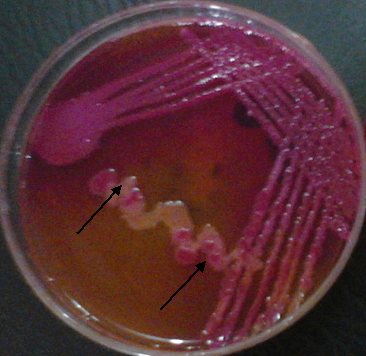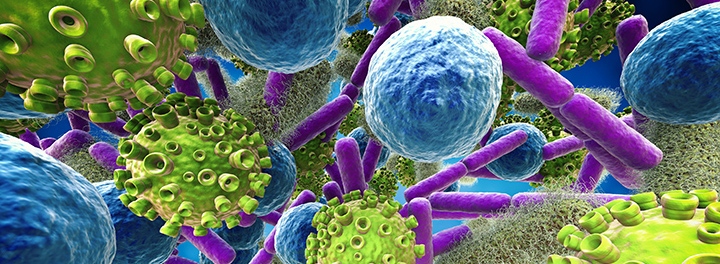GARDNERELLA VAGINALIS
Gardnerella vaginalis in association with other bacteria is the causative agent of bacterial vaginosis (BV) in women. G. vaginalis is a Gram variable (i.e. they are not typed by the Gram stain), encapsulated, facultative, pleomorphic and non-motile bacillus. BV which can also be called vaginitis is a medical condition that is characterized by the discharge of whitish or grey substances from the vagina of a woman. There is usually itching, pain and fowl-smelling or bad odour that accompanies the discharge.
In this circumstance, the normal bacterial flora of the female vagina is replaced by anaerobic pathogens including Mobiluncus species, Bacteroides species, Prevotella species, and G. vaginalis amongst others which invade the vaginal region and take over the normal flora working condition of the area. G. vaginalis is a normal flora of the female genital mucosa and only cause BV when the normal flora condition of the vagina changes. Trichomonas vaginalis (a protozoan and Candida albicans (fungal yeast) are other causes of BV in women that are reproductively mature.
PATHOGENESIS OF GARDNERELLA VAGINALIS INFECTION
The pathogenesis of bacterial vaginosis (BV) is often multifaceted due to the fact that the infection is caused by an assemblage of different bacterial species of which G. vaginalis is one of them. The vagina of a sexually mature female is largely inhabited by Lactobacillus species aside other bacteria as the normal bacterial flora of the site from puberty to menopause. L. acidophilus converts glycogen in the vagina to lactic acid (via fermentation) – which maintains a low pH (i.e. a weakly acidic environment) that prevents anaerobes from thriving and causing infection in the vagina.
The female vagina is usually alkaline before puberty and thus glycogen is not produced. Staphylococcus, Diphtheroids, E. coli and Streptococcus species are the bacterial population that makeup the normal flora of the vagina before puberty. But after puberty and until menopause, these bacterial species become replaced by Lactobacillus acidophilus as glycogen production is restored. However, glycogen production stops after menopause and this returns the normal flora of the vagina to the state it was before puberty as the pH of the site rises. In bacterial vaginosis (a non-specific and non-inflammatory infection of the vagina), there is an alteration of the normal flora of the vagina which gives room for G. vaginalis and other anaerobes to take over the genital mucosa of the vagina and thrive.
Thus, BV is a medical condition that arises in sexually mature women when there is a shift (i.e. a change from the normal to the abnormal) in the female vagina flora which allows obligate anaerobic bacteria to overgrow. Conditions that lead to the alteration of the normal flora of the female vagina may include change in pH of the vagina, antibiotic usage and poor hygiene. In BV, cells known as “clue cells” usually accompany the malodourous discharge from the vagina. Clue cells are vaginal epithelial cells covered with bacteria cells.
LABORATORY DIAGNOSIS OF GARDNERELLA VAGINALIS INFECTION
As much as possible, BV should be differentiated from normal vaginal discharge in women, vulvovaginitis due to C. albicans and vaginitis due to T. vaginalis.The discharge of grey or whitish fluids from the vagina is usually attributed to the infection of the vagina, uterus or cervix. Thus, BV is often diagnosed by the examination of vaginal discharge through microscopy, culture, wet mount preparation (to detect motility), and by conducting the “whiff test”. Vaginal swab is aseptically obtained for microscopy and culture where necessary. Clue cells are seen in microscopical examination of vaginal discharge from a BV patient.
In the whiff test, the fowl-smelling odour of the discharge from the vagina is intensified to a fishy odour by the addition of 10% potassium hydroxide (KOH). The vaginal discharge is placed on a glass slide upon which 10% KOH is added; and the production of a fishy-like odour (due to the volatilization of amine) is indicative of a BV. In BV, polymorphonuclear (PMN) cells are absent, and the disease is not an inflammatory process. G. vaginalis is either Gram-negative or Gram variable; and it can be cultured in blood agar in the presence of 5% CO2. BV is also suspected when the pH of the vaginal fluid is above its normal level. The pH of the normal vagina is < 4.5 while pH above 4.5 indicates an abnormal vaginal condition.
IMMUNITY TO GARDNERELLA VAGINALIS INFECTION
Bacterial vaginosis is the most common form of vaginitis in sexually mature women. And it increases the chances of women to acquire a sexually transmitted disease (STD) if not treated clinically. No vaccine exists for the disease, and women who have suffered from the disease presents with no form of active immunity against a re-infection. The shifting nature of the female vaginal flora is largely responsible for the development of the disease; and care to the area can help in abating bacterial vaginosis infection in women of reproductive age.
TREATMENT OF GARDNERELLA VAGINALIS INFECTION
The treatment of bacterial vaginitis is done orally using metronidazole, an antibacterial agent which helps in clearing the infecting bacterial pathogen from the vagina.
PREVENTION AND CONTROL
Bacterial vaginosis (BV) is a mild bacterial infection in women who are sexually mature. If left unattended, it may predispose a woman to still birth or preterm birth and pelvic inflammatory disease (PID). Adequate care should be given to the female vagina owing to its large surface area and known secretion of mucous at the vaginal wall. This phenomenon allows for a shift of the vaginal normal flora, thus giving room for obligate anaerobic bacteria to thrive and cause vaginitis. Having multiple sex partners, using public toilets, beddings and public swimming pools can predispose women to acquiring vaginitis. Thus, caution should be taken when engaging in any of these activities.
References
Brooks G.F., Butel J.S and Morse S.A (2004). Medical Microbiology, 23rd edition. McGraw Hill Publishers. USA. Pp. 248-260.
Madigan M.T., Martinko J.M., Dunlap P.V and Clark D.P (2009). Brock Biology of microorganisms. 12th edition. Pearson Benjamin Cummings Publishers. USA. Pp.795-796.
Prescott L.M., Harley J.P and Klein D.A (2005). Microbiology. 6th ed. McGraw Hill Publishers, USA. Pp. 296-299.
Ryan K, Ray C.G, Ahmed N, Drew W.L and Plorde J (2010). Sherris Medical Microbiology. Fifth edition. McGraw-Hill Publishers, USA.
Singleton P and Sainsbury D (1995). Dictionary of microbiology and molecular biology, 3rd ed. New York: John Wiley and Sons.
Talaro, Kathleen P (2005). Foundations in Microbiology. 5th edition. McGraw-Hill Companies Inc., New York, USA.
Discover more from Microbiology Class
Subscribe to get the latest posts sent to your email.





